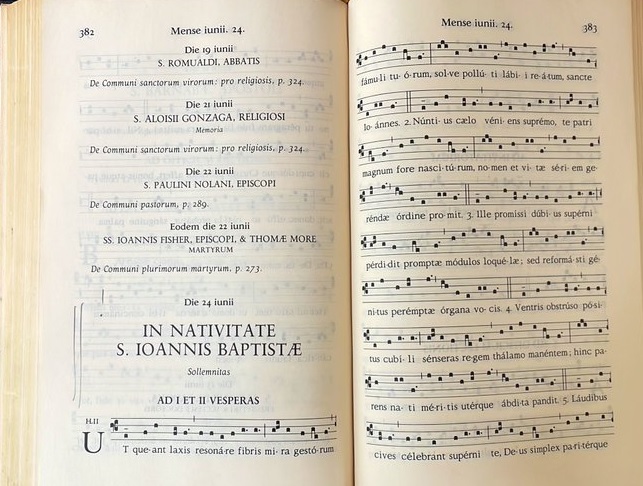There are lots of customs for the Vigil and the Feast of St. John the Baptist. Romans eat snails. Romans also would gather certain plants that were mature by this point, such as what we call St. John’s Wort, along with onions and garlic, which they thought drove off witches and demons. St. John’s Wort (Hypericum perforatum)… “Wort” is from Old English wyrt (German Würze), which means “plant”, but is used mostly in compounds. Since ancient times “singent’s wort” was known to relieve melancholy or depression, as does borage… which every garden should have. It would be hung above doors, windows and sacred images (hence the hyper-icum “above image”) to keep witches and evil spirit away. Burning those witches might have something to do with its effectiveness as well, now that I think about it. In Germanic countries witches were burned in effigy, which was handy because there is a special Blessing for Bonfires.
Also, we sing the lovely Vespers hymn Ut queant laxis.
I made a podcast about this years ago. 2007!
36 07-06-24 St. Augustine on John the Baptist; Ut queant laxis
Another world.
In 2012:
129 12-06-20 Of the solstice, and The Baptist, and summer poems
A lot of tears under the bridge since then.
It is the time of the Summer Solstice. At this point the days get shorter in the Northern Hemisphere. I looked at that HERE and HERE.
 For the feast of St. John in June for centuries the Church has sung at Vespers the hymn beginning Ut queant laxis.
For the feast of St. John in June for centuries the Church has sung at Vespers the hymn beginning Ut queant laxis.
If you want to hear Ut queant laxis sung “in the wild”, as it were, check out the Benedictines at Norcia, a fine group of men, really living the Benedictine life in the place where Benedict is said to have been born. Chant album HERE). Also, check the monks at Le Barroux. Hard core. Fantastic chant. HERE
Those of you who are lovers of the movie The Sound of Music will instantly recognize this hymn as the source of the syllables used in solfège or solmization (the use of syllables instead of letters to denote the degrees of a musical scale). Both the ancient Chinese and Greeks had such a system.
The Benedictine monk Guido d’Arezzo (c. 990-1050) introduced the now familiar syllables ut re mi fa sol la for the tones of the hexachord c to a… or, more modally, the tonic, supertonic, mediant, etc. of a major scale. The Guidonian syllables derive from the hymn for the feast of St. John the Baptist:
UT queant laxis
REsonare fibris
MIra gestorum
FAmuli tuorum,
SOLve polluti
LAbii reatum,
Sancte Ioannes (SI).
After the medieval period (when music became less modal and more tonal) to complete the octave of the scale the other syllable was introduced (si – taken from S-ancte I-oannes, becomes “ti”) and the awkward ut was replaced sometime in the mid 17th c. with do (or also doh – not to be confused in any way with the Homeric Simpsonic epithet so adored by today’s youth, derived as it is from the 21st century’s new liturgical focal point – TV) and do came to be more or less fixed with C though in some cases do remains movable.



































Solfege and sight singing. Just another unappreciated gift from Catholics.